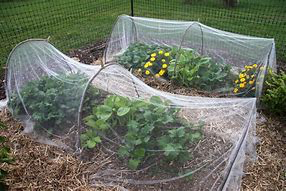Row covers are practically the only way to protect vegetable crops against a number of pests while still maintaining organic gardening practices.
Properly installed covers — ones which fully enclose the planting space — provide a physical barrier against the adult female insects laying their eggs on the plants.
Effective row covers consist of four main components: 

- A framework for supporting the mesh covering.
- A fine mesh cover.
- Clips or other fasteners to secure the mesh to the framework.
- A means to hold the mesh down to or beneath the soil
- Frames to support the mesh covering may be either purchased from a number of sources, or made by yourself.
- Homemade frames can be rectangular and made from wood, or arched hoops made from either 1/2” aluminum conduit or PVC, bent to shape.
- We do have a bending jig near the “parts corral.”
Reminders:
- Crops such as peas, strawberries, beans, pumpkins and squash require pollination to produce a harvest.
- If these crops are still covered with fabric when they begin to flower, remove or temporarily lift fabric from the beds during the day to allow bees to do their work.
- Self-pollinating plants, such as tomatoes, can be left covered.
- However, be aware of the temperature under the covers.
- At temperatures above 85 degrees F., tomato pollen may become sterile and peppers will not set fruit.
- You may need to lift the covers during the day to release excess heat.
An alternative means to controlling flies and other insects that spend their larval stage munching on vegetable roots are root collars or cylinders.
